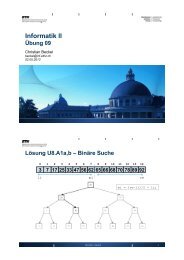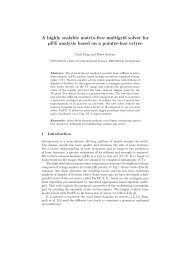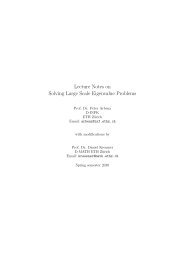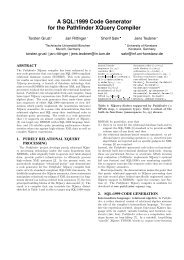Codon Evolution Mechanisms and Models
Codon Evolution Mechanisms and Models
Codon Evolution Mechanisms and Models
Create successful ePaper yourself
Turn your PDF publications into a flip-book with our unique Google optimized e-Paper software.
scope of this review, since for many indices no<br />
implementation is available.<br />
We have investigated the dependence of the<br />
indices on properties of the sequences using<br />
simulations. We have also estimated the extent<br />
to which the indices capture different aspects of<br />
expression-based experimental data. To this end,<br />
we measured the correlation of the indices with<br />
mRNA <strong>and</strong> protein abundance data, as well as an<br />
estimated rate of synthesis. A statistical framework<br />
in which all methodologies could be evaluated in<br />
a systematic manner would be desirable to answer<br />
questions of performance.<br />
The choice of index depends on the task, as different<br />
indices measure different aspects of codon<br />
usage. To predict protein yield for over-expression<br />
of heterologous proteins, the PLS measure performs<br />
well when the goal is to optimize yield in protein<br />
production (Welch et al., 2009). In such cases,<br />
tRNA depletion becomes a limiting factor <strong>and</strong> thus<br />
codons less sensitive to starvation become preferable.<br />
The codon adaptation index (CAI) is a long<br />
used method for measuring codon usage bias <strong>and</strong><br />
has the advantage of being widely known <strong>and</strong><br />
understood. In particular, the version by Carbone<br />
et al. (2003) is convenient <strong>and</strong> remains a good choice<br />
for measuring codon usage bias (Friberg et al., 2004),<br />
as it does not require external knowledge, such<br />
as optimal codons or anticodon–codon mapping.<br />
Other studies have also provided recommendations<br />
for which indices to use (Supek <strong>and</strong> Vlahovicek,<br />
2005).<br />
Several different complementary indices can be<br />
used to underst<strong>and</strong> the diversity of codon usage<br />
among genes <strong>and</strong> organisms as they sometimes<br />
capture different aspects of evolution. It may be<br />
that an amalgam of indices may provide improved<br />
performance. For example, a combination of indices<br />
that capture different aspects of translation can be<br />
used as a better classifier for predicting translation<br />
efficiency (Tuller et al., 2004).<br />
In our opinion there is room for improvement,<br />
in particular, for predictions towards functionality,<br />
regulation, <strong>and</strong> lowly expressed genes. In addition<br />
to the obvious requirements of being theoretically<br />
sound <strong>and</strong> adequately described, a few points<br />
should be observed when devising a new index<br />
of codon usage. Any new index should have an<br />
REFERENCES 213<br />
accessible implementation. If possible, the source<br />
code of the implementation should be accessible<br />
in order to facilitate verification <strong>and</strong> underst<strong>and</strong>ing.<br />
A web-interface (preferably including a web<br />
API) <strong>and</strong> downloadable binaries are essential. If<br />
the index is to reach the intended audience, the<br />
importance of a proper implementation can not be<br />
underestimated.<br />
References<br />
Adzhubei, A.A., Adzhubei, I.A., Krasheninnikov, I.A.,<br />
<strong>and</strong> Neidle, S. (1996). Non-r<strong>and</strong>om usage of ’degenerate’<br />
codons is related to protein three-dimensional<br />
structure. FEBS Lett, 399(1-2): 78–82.<br />
Akashi, H. (1994). Synonymous codon usage in drosophila<br />
melanogaster: natural selection <strong>and</strong> translational accuracy.<br />
Genetics, 136(3): 927–35.<br />
Angellotti, M.C., Bhuiyan, S.B., Chen, G., <strong>and</strong> Wan,<br />
X.-F. (2007). <strong>Codon</strong>O: codon usage bias analysis within<br />
<strong>and</strong> across genomes. Nucleic Acids Res, 35(Web Server<br />
issue):W132–6.<br />
Bailly-Bechet, M., Danchin, A., Iqbal, M., Marsili, M.,<br />
<strong>and</strong> Vergassola, M. (2006). <strong>Codon</strong> usage domains over<br />
bacterial chromosomes. PLoS Computational Biology,<br />
2(4):e37.<br />
Begley, U., Dyavaiah, M., Patil, A., Rooney, J.P., DiRenzo,<br />
D., Young, C.M. et al. (2007). Trm9-catalyzed tRNA<br />
modifications link translation to the DNA damage<br />
response. Mol Cell, 28(5): 860–70.<br />
Belle, A., Tanay, A., Bitincka, L., Shamir, R., <strong>and</strong> O’Shea,<br />
E.K. (2006). Quantification of protein half-lives in the<br />
budding yeast proteome. Proc Natl Acad Sci USA,<br />
103(35): 13004–9.<br />
Bennetzen, J.L. <strong>and</strong> Hall, B.D. (1982). <strong>Codon</strong> selection in<br />
yeast. J Biol Chem, 257(6): 3026–3031.<br />
Beutler, E., Gelbart, T., Han, J.H., Koziol, J.A., <strong>and</strong> Beutler,<br />
B. (1989). <strong>Evolution</strong> of the genome <strong>and</strong> the genetic code:<br />
selection at the dinucleotide level by methylation <strong>and</strong><br />
polyribonucleotide cleavage. Proc Natl Acad Sci USA,<br />
86(1): 192–6.<br />
Bodilis, J. <strong>and</strong> Barray, S. (2006). Molecular evolution<br />
of the major outer-membrane protein gene (oprF) of<br />
Pseudomonas. Microbiology, 152(Pt 4): 1075–88.<br />
Bulmer, M. (1987). Coevolution of codon usage <strong>and</strong> transfer<br />
RNA abundance. Nature, 325(6106): 728–30.<br />
Cannarozzi, G., Schraudolph, N.N., Faty, M., von Rohr,<br />
P., Friberg, M.T., Roth, A.C. et al. (2010). A role<br />
for codon order in translation dynamics. Cell, 141(2):<br />
355–67.









